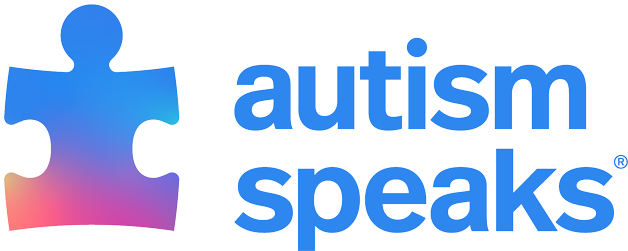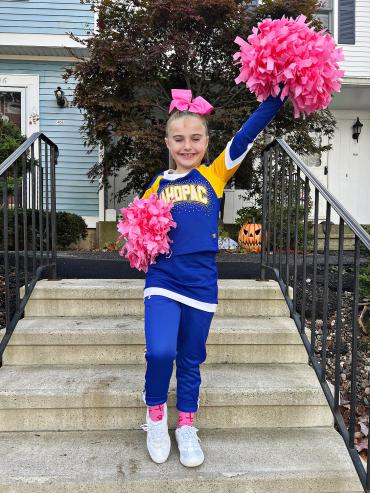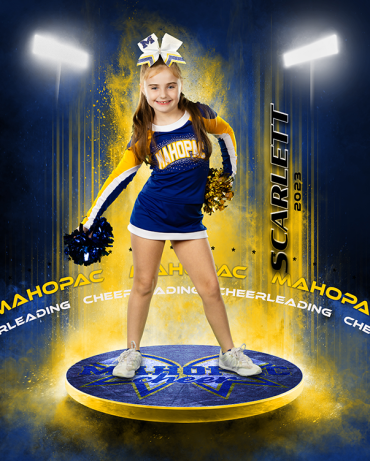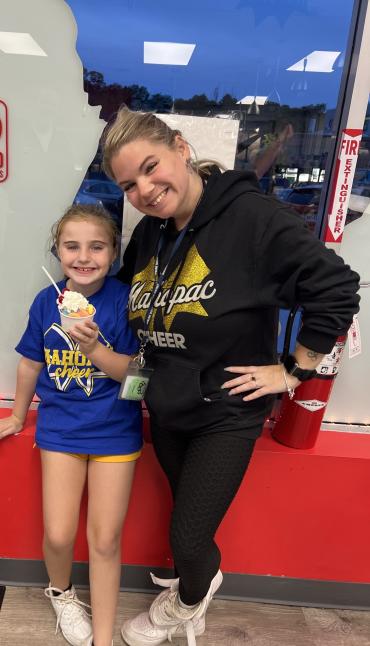The benefits of physical activity and a healthy lifestyle
Cheering on a new hobby
When Scarlett, 8, was transitioning into a new school and a new way of learning inside an Integrated Co-Teaching (ICT) class for second grade, her mom, Caitee, knew the transition period would be crucial. Prior to the beginning of the school year, she decided to research local activities for children in the school district and happened to stumble across cheerleading.
Immediately, a light bulb went off in Caitee’s mind.
“Honestly, it was perfect timing because it started in August, which meant Scarlett would have a chance to meet some of the children prior to the school year and hopefully get a head start with making friends. I spoke to her about it and showed her videos of cheerleading. She seemed very excited and agreed to try it without hesitation!”
Like many autistic children, Scarlett is sensitive to sound and can become overstimulated in loud environments, so Caitee knew she would need to prepare her daughter for some of the new sights and sounds she’d be experiencing as a member of a cheer squad. To make her more comfortable, her mom informed the program director of her diagnosis and arranged some minor accommodations.
"Scarlett isn’t a fan of loud noises, so we wanted them to be aware in case she covered her ears or seemed distracted. They started with the music lower than it would usually be and accommodated her as best as they could in many ways. She did absolutely fantastic and has not needed any extra accommodations since!”
Scarlett needed some time to adjust to the many changes in her daily routine that cheerleading brought to her life, but her mom says her immediate attraction to the sport quickly erased any initial hesitations she might have had.
“Scarlett has learned routines, sideline cheers and has had her position moved multiple times to work the routine for the best scoring positions. She is very regimented so having her routine changed can be a challenge for her. But she truly loves cheerleading, so she just keeps doing whatever she needs to do for her squad.”
Caitee also decided to volunteer as a “Team Mom” so she could be at practices and help out behind the scenes just in case Scarlett needed her for support. Whether it’s as an at-home dance partner or simply being a listening ear or a shoulder to lean on when new challenges arise, this cheer mom says she’ll do whatever it takes to see her daughter smile.
“This season, her team was very large with 28 girls total! So her place in the routine changed quite a few times, which stressed her out a little bit. I learned the routine with her and would practice with her at home. I’m always reminding her that coming in first place is nice, but we’re doing this for fun. As long as she tries her best and is enjoying herself, that is what counts.”
Outside of helping her to grow socially and learning to believe in herself, cheerleading has inspired a shift in how Scarlett and her family view health and fitness as it relates to her autism.
“Learning how to practice healthy habits on a regular basis has given Scarlett another thing to learn about herself. By staying healthy and strong, it makes her feel more confident and allows her to keep pursuing cheerleading and other things she enjoys. She knows she needs to eat more healthy food, get a good night’s rest and take care of her body. With that, she can experience so many cool things in life, and I think she’s realizing that day by day.”
Scarlett’s story shows that with a little perseverance, children with autism can have healthy and fulfilling recreational experiences that make their lives fuller. If you are a parent of an autistic child, these tips can help you support them through their fitness journey:
- Work with your child to choose an activity that aligns with their skills and interests.
- Ask the organizer if you and your child can observe a session. This will help your child decide whether the activity is a good fit and help you identify potential challenges.
- Consider the experience from multiple perspectives — sensory, social, communication, routine.
- Use familiar strategies that your child uses at home or in school, like a visual schedule, communication cards or a wiggle seat.
- Think about the supports needed before and after the activity. For example, your child may benefit from a social story before the activity, or they might need plenty of time to get ready to keep stress levels low. Afterwards, they may need quiet time to recover from a sensory-intensive activity or an opportunity to move after a sit-down activity.
- Consult with your child’s IEP team about possible accommodations for after-school clubs, sports, or other activities your child wants to try.
Learn more about recreational activities for children with autism and read helpful resources and tips from other parents to the right hobbies for your child.











